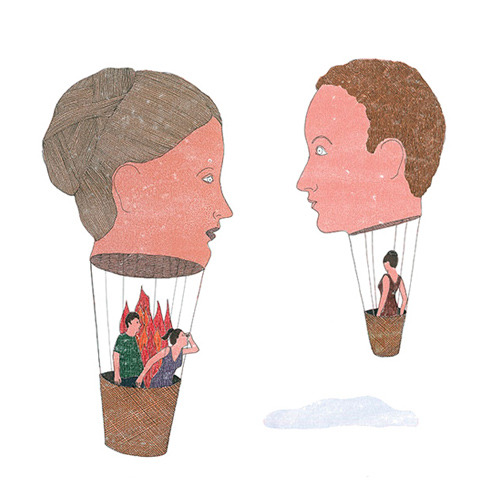< Back to posts
Marion Fayolle
France

Marion Fayolle graduated with a degree in illustration from the School of Decorative Arts in Strasbourg. She's illustrated numerous books and has produced illustrations for magazines and newspapers such as The New York Times. In 2009, Marion co-founded the acclaimed French illustration magazine, Nyctalope.
In this post, Marion talks about the creation of ‘L'Homme en pièces’ (In Pieces). This beautiful book of visual poetry examines human relationships through metaphors, allegories and symbolism.
Marion: ‘In Pieces’ is a book that I made while I was still a student at the School of Decorative Arts in Strasbourg. It was my graduation project – the conclusion of five years of studying and the setting up of the foundations of my visual language. I'm still very attached to this work. Before this, I would only make single images and simple illustrations, and this was the first time that I tried to tell a story.
When I write my stories, I don't really write. Everything starts with the desire for an image, which is often obtained through an association between shapes and words. For example, I think that a woman's dress has an odd resemblance to a birdcage. This image in my mind will be my base, my starting point, the first word of the first sentence. Next, I need to animate this character, make her come alive, find a justification for her dress-cage, make her react to the other actors.
Things are written through drawing: I mentally project the images, not the words. The narration flows in the form of an improvisation. I perform the scene myself to find out what happens next – to think of a fall. I imagine myself as the woman-cage, the wife of a foldable husband, the mother of a child that grows when you water him like a plant, or even a woman with a skirt that is a tent under which men rest quietly. Becoming the character allows me to think of the continuation of the narrative, not by writing it, but by living it, mimicking it, visualising it.
When I make comics, there is no synopsis, no summary. Sometimes I take some short notes, but I see only images. I don't start with a wish to say something; I don't have a background or a precise text to illustrate. I work the other way around: I start from a fixed image, a graphic metaphor, and then I animate it, I justify it, and little by little my stories find a meaning. I never know what I am going to say before saying it.
My characters have no voice. They are objects. Like glass vases, they can break. Like candles, they can be blown out. Like puzzles, they can be unfinished. Like cakes, they can be divided into equal pieces. Like a potted plant, they can be watered. But you can be reassured that they do not suffer. They don't bleed. Everything is possible because they are not truly living, because they do not speak. They are mere playthings, humble puppets. They incarnate ideas and concepts. They become allegories and metaphors. They have no voice, no given name, no past, they talk with their bodies, they present crazy theories about things.
Visually, I like the idea of a dress that fades away in the hands of the man that touches it.
I find it interesting to think that people are like kites, that they are connected with each other by thin twine. It is so absurd to believe that when a couple gets divorced, the man and the woman split the child like they split their assets. Cutting her in two is an effective solution!
In my silent comics, everything is allowed. If the first image I create suggests that a woman's genitalia is like a lettuce, then what comes next will sustain this proposition until it is made plausible. The lettuce, obviously, will be devoured by a rabbit-man, but not completely, because the hunter will kill him. We stop there. Sometimes, my narratives have an ending, and then one day I continue them further. It is as if nothing is settled or definitive. The rabbit is dead; the woman's lettuce is damaged. We then come to realise that the hunter and the woman are accomplices. He gives her a new lettuce, fresh and beautiful. So now, more greedy rabbits will inevitably fall into the trap!
My stories are very short. I contemplate them like poems. They are fables in images, mime shows, little ballets. In any case, this is how I would like them to be read. When we have a comic or a novel in our hands, there is an order in which we must read them. But when we discover a book of poems or short stories, we can read them bit by bit: a title pleases us, makes us smile, and then we start by reading that fable, even if it is in the middle of the book. Later we discover the other stories. I find this idea of random reading very interesting and perfectly suited to a comic that is mainly poetry in images.
Illustrations © Marion Fayolle. Post translated by Gengo and edited by dPICTUS.
L'Homme en pièces / In Pieces
Marion Fayolle
Michel Lagarde, France, 2011
Éditions Magnani, France, 2016
‘In Pieces’ beautifully captures the complex bonds in human nature. The silent narrative of each story leaves a lasting impression.
A man comes home to his lover, his hands tainted by the dress of another woman. A few pages later, a couple fight for the custody of their daughter to the point where she’s literally cut in two.
‘In Pieces’ is a beautiful book of visual poetry, in which metaphors are explained through images.
- French: Michel Lagarde — Éditions Magnani
- English: Nobrow











